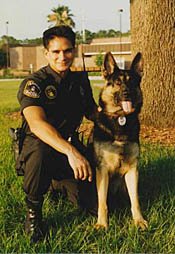If your agency has patrol K9’s then you have probably worked with the dogs and handlers at some point. Deployment protocols vary among departments, and from differing geographic terrains. Tracking K9 units need help from their patrol counterparts.
A K9 team cannot track as fast as a suspect can run. Contrary to how it looks, the dog does not pull the handler along for the ride. The handler’s job during tracking is to read and guide his dog. This involves sometimes slowing the dog’s pace and assisting it over obstacles.

A fleeing suspect can usually run between a six and ten minute mile, assuming he’s not trying to bed down and hide. This pace will far exceed the speed of a dog team. Added to the equation is the time lapse of the call, or head start the bad guy has. Because of this, a K9 perimeter is essential for suspect containment.
An appropriately set K9 perimeter encircles the area of the suspect and K9 team with police cars in an attempt to keep the suspect inside. When the suspect sees the lights on the cruisers, it can cause him to go to ground to avoid detection. Conversely, a suspect crossing the lights of the police cars will give officers the opportunity to spot the perpetrator and either capture him outright or radio his or her location to the tracking K9 unit.
The key to a successful perimeter is managing the resources. No agency has an endless amount of patrol units to devote to every call. If your department has a responding officer set a perimeter while the K9 is enroute, then you know how tricky it can be.
When I was a K9 handler, I would advise newer officers that it is basically better to set a large perimeter than one too small. It is of no help to toss out a net if the fish has swum away. If your complainant has a visual on the suspect at the time units are arriving, then a smaller containment is called for.
If you are the primary unit setting a perimeter, stop your car and consult the map. It is best to set your cars along straight roads in a box formation, if at all possible. If the officers can see each other’s lights, then it will help them detect if someone is crossing the perimeter.
Time is important and quickly getting the best perimeter you can is the key. Experienced officers will know well-used escape routes and put cars in those locations based on prior knowledge of their beats. If the K9 track crosses the perimeter, it is your job to reset officers to compensate and keep the containment working.
The best way to move a perimeter is to jump the units farthest away from the action to new positions on the opposite side of the “box.” Since everyone seems to want to play when the track is hot, use the extra cars to plug holes in the containment.
Once you have arrived at your perimeter position, throw up that “wall of light” and begin observing your immediate surroundings. I tracked and caught one felon not ten feet from a perimeter officer’s cruiser. When the officer pulled up, the suspect had nowhere to run, so he lay still and unseen in a small bush near the car.
Responding officers need to listen to the K9’s as they radio their updated locations. You may be the nearest unit to assist them in the event they call for help. Radio traffic for the perimeter units should be on a separate channel from the K9 team, to keep the air clear for them.
Officer safety is always the main concern. Believe that on a hot call, you are as likely to encounter the armed bad guy as the K9 team is. We can wait to write that holding report until after the call is over.
Without question, more suspects are caught when patrol units and K9 teams work in unison. Happy hunting!
Randall spent eight years as a Police K9 handler. His two German Shepherd Dogs were trained for Patrol, Narcotics, and SWAT. He also handled a narcotics-trained Labrador Retriever.